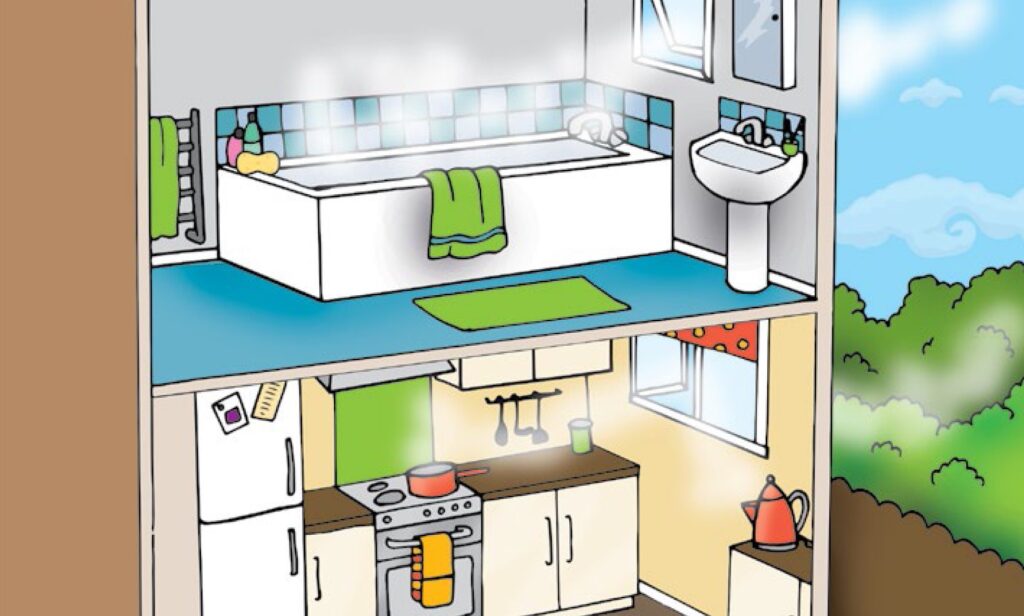There is always some moisture in the air. Condensation occurs when the air gets so cold that it cannot hold all the moisture and tiny droplets of water appear. You will notice condensation when you breathe on a cold day and when the mirror mists over when you have a bath.
Condensation usually occurs when there is a big difference between the temperature inside your home and the temperature outside, so it occurs most often in cold weather. Condensation will form on cold surfaces within the home and in places where there is little air movement, such as corners, behind wardrobes and cupboards.
Soft furnishings can also have condensation form on them and often absorb moisture from the air. There is usually a musty smell where condensation forms.
Condensation does not leave a ‘tidemark’ (this is the mark left by dampness after the moisture has dried). Other forms of dampness such as rising damp and leaks from plumbing often do leave ‘tidemarks’.
If condensation is allowed to happen on a regular basis, mould can form on walls
and furniture. Mould usually appears on the inside of external walls – often forming on north-facing walls – and tends to get worse in cold weather.
Some types of dampness are not caused by condensation.
Penetrating damp, caused by leaking pipes, wastes and overflows. Or by rain getting through holes in roofs, spilling from a blocked gutter or leaks through cracked pipes. Penetrating damp will show as a damp patch on the walls or paint may be peeling off.
Rising damp, caused by faulty damp course. Rising damp could lead to a white salt like substance appearing up to a metre above ground level. Both these types of damp leave ‘tidemarks’.
1. Produce less moisture
Every day the average UK household puts about 12 litres (around 20 pints) of moisture into the air in their home. In homes where clothes are dried indoors, or where paraffin or bottled gas heaters are used, the total amount of moisture being produced can be over 20 litres (36 pints) a day*.
Some everyday daily activities produce a lot of water very quickly for example cooking, use of bottled gas heaters and washing/drying clothes.
- Cooking – Always cook with lids on pans and turn the heat down once water has boiled, this keeps the steam that causes condensation under control and will also save energy.
- Washing and drying clothes – Dry washing outside if possible. If drying washing indoors is unavoidable, then dry it in a closed, heated and well ventilated room, such as a bathroom, with the window slightly open. If there is an extractor fan fitted, use it. Avoid drying clothes on radiators or in front of a radiant heater.
- Using a tumble dryer – If you use a tumble dryer, make sure it is ventilated directly to the outside air. Venting kits are available for many popular brands of dryer. Avoid tumble dryers that vent directly into the room.
- Filling your bath – Run the cold water first then add the hot. This will reduce the steam that causes condensation by 90%. This can also save energy as you are not using hot water unnecessarily. Try to keep a window slightly open for the steam to escape.
- Bottled Gas Heaters – Avoid using these heaters. They produce a lot of moisture which causes condensation. An average gas cylinder produces about 8 pints of moisture. These heaters are NOT recommended.
2. Ventilate to Remove the Moisture
Ventilation can help to reduce condensation by removing moist air and replacing it with drier air from outside. You can ventilate without making draughts.
- Cross-ventilate your home – Try to cross-ventilate your home at least once a day for 30 minutes. To cross-ventilate your home open windows (they do not need to be wide open, slightly open is fine) at opposite sides of the house, or diagonally opposite if you live in a flat. At the same time open interior room doors, this will allow the drier outside air to circulate through your home. NB: Opening accessible windows may cause a security risk. Remember to close all windows when you go out.
- Occupied rooms – In occupied rooms some ventilation is needed all of the
time. This is to get rid of the moisture being produced, which includes water vapour produced by breathing. Keep a small window ajar or a trickle vent open. - Ventilate bedrooms – Try to leave a bedroom window slightly open at night, or use trickle vents if fitted. This will allow moisture that causes condensation to escape. Remember to think about security. Do not overfill cupboards and wardrobes. Overfilling reduces air circulation and increases the risk of mildew forming on clothes. Leave sufficient space to allow air circulation between the backs of large furniture, such as wardrobes. Avoid locating wardrobes and large furniture against external walls wherever possible.
- Kitchens and bathrooms – These rooms need more ventilation when you cook, wash up, bathe or dry clothes. You will need to open windows and use cooker extractor hood or extractor fan, if fitted. They are relatively cheap to run and very effective. Close kitchen and bathroom doors whilst these rooms are in use and for a while afterwards to allow the moisture to be vented to the outside. This will help to reduce the passage of moisture to other parts of your home.
3. Reduce cold surfaces in your home
Condensation commonly forms on cold surfaces within the home. Loft insulation, cavity wall insulation and draught proofing windows and external doors will help keep the surfaces within your home warm. When the whole home is warmer, condensation is less likely, plus fuel consumption should be reduced, having potential to lower fuel bills.
When fitting draught proofing:
- Do not draught proof rooms that have a condensation problem, they will
benefit from extra ventilation - Do not block permanent ventilators or airbricks that have been installed
for heating or heating appliances - Do not draught proof rooms wherethere is a fuel burning heater (gas fire) or cooker
- Do not draught proof windows in the bathroom and kitchen, the steam
produced in these rooms needs to escape and be replaced by drier outside air.
4. Heat your home effectively
Keep your home adequately heated when occupied (ideal temperature 18°C – 24°C). Try to keep a reasonable level of heat throughout your home. Heating one room to a high level and leaving other rooms cold can make condensation problems worse in the unheated rooms. Warm air will always try to escape to
the colder areas of the home, once the warm air hits the cold surfaces condensation will occur.
If you don’t have heating in every room, try to leave the doors of unheated
rooms open to allow some heat into them. If it is necessary for you to have additional heating in rooms without central heating, use plug in electric oil filled radiators or panel radiators, with thermostatic controls (use a low setting). The thermostatic control will ensure that the heater is not using constant electricity. Try not to use electric fan heaters, as these will use a lot of
your electricity.
If you follow the advice in this leaflet, it is less likely mould will form in your home. However, if condensation has led to mould growth, it is better not to leave it untreated.
If treated at an early stage, mould should not reappear. Any condensation on windows and window sills should be dried every morning, wringing out the cloth rather than drying it on a radiator. Wiping down walls and window frames with a fungicidal wash, should kill and remove mould. If you are attempting this yourself, please make sure you wear rubber gloves and follow the manufacturer’s instructions carefully.
Any mildewed clothes will need to be dry cleaned and carpets shampooed thoroughly. Brushing or vacuuming mould is not advisable, as this will cause mould spores to be released into the air which can cause breathing problems.
After treatment, surfaces may need to be redecorated using a good quality fungicidal paint to help prevent mould. Fungicidal paint is not effective if overlaid with ordinary paints or wallpaper. Using wallpapering paste that contains a fungicide, will also help prevent further mould growth.
The only lasting way of avoiding severe mould build up is to prevent condensation. If you are struggling with mould build up in your home, please get in touch.
1.Produce less moisture
- Cover pans
- Dry clothes outdoors
- Vent your tumble dryer to the outside
- Fill your bath with cold water first
- Avoid using paraffin or flueless bottled gas heaters.
2. Ventilate to remove moisture
- Ventilate all the time, especially when someone is at home
- Increase ventilation of the kitchen and bathroom when in use and shut the door
- Don’t overfill cupboards, wardrobes.
3. Reduce cold surfaces
- Contact Jigsaw to find out about loft insulation and cavity wall insulation
- Draught proof windows and external doors.
4. Heat your home effectively
- Keep your home adequately heated throughout when occupied (ideal temperature 18ºC – 24ºC).
*Building Research Establishment; Good Repair Guide 7 – Treating Condensation in Houses.
Click here to download a copy of the Condensation and mould leaflet.


